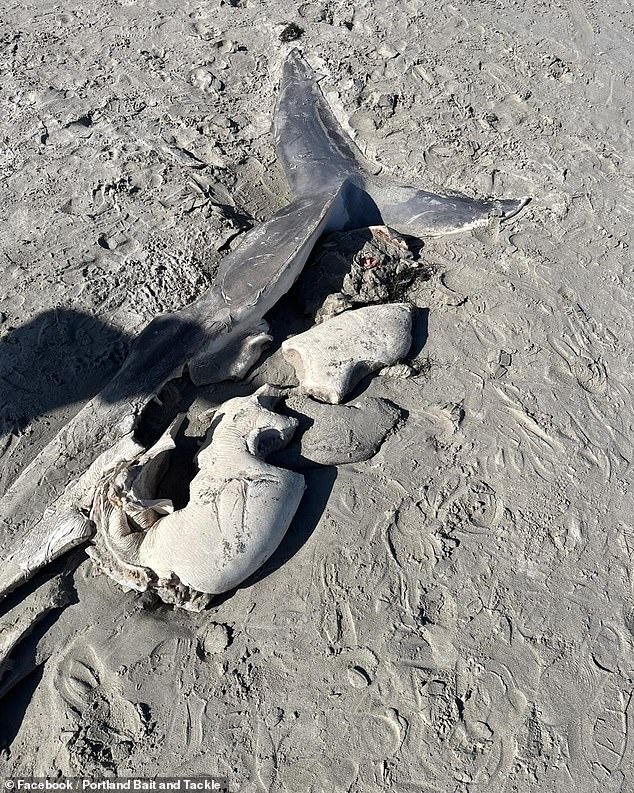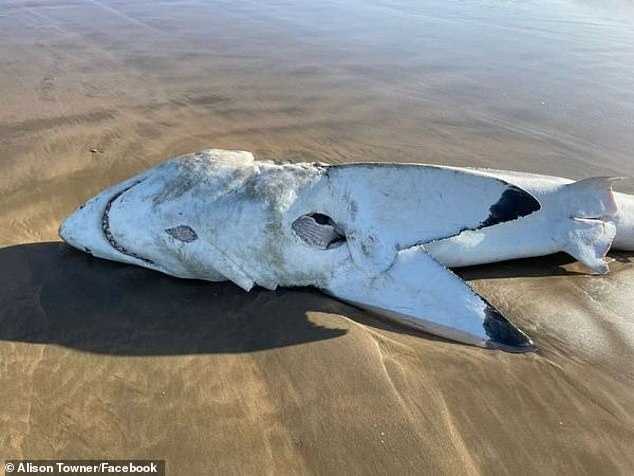Scientists confirm which animal violently ripped large chunks of flesh from a great white shark that washed ashore in Australia
When a dead great white shark washed up on an Australian beach in October, authorities immediately suspected foul play.
The shark's stomach has been slit open, a rare development for one of the ocean's most fearsome predators.
Now scientists have confirmed who killed the giant predator: a killer whale, or more likely a group of killer whales.
Dr Adam Miller from Deakin University announced this week that scanning bite wounds revealed traces of killer whale DNA.
The great white shark washed ashore. Its head and spine were intact but its liver was missing. The signs pointed to killer whales
“We effectively took genetic samples, swabbed the bite wounds,” said Miller, an assistant professor of aquatic ecology and biodiversity. He told ABC Radio Melbourne.
“We were able to confirm that these bite wounds were loaded with killer whale DNA. So it's just smoking gun.”
The shark in question is about 16 feet long, Miller said.
This is relatively large by great white standards, with the largest individuals reaching about 20 feet in length and weighing up to about 4,400 pounds.
Great white sharks may be giant, but killer whales are even bigger, ranging from 20 to 26 feet long and weighing more than 13,000 pounds.
The mutilated remains were found on a beach at Bridgewater Bay in Victoria, across Port Phillip from Melbourne.

The carcass of the great white shark was found in October, washed up on Bridgewater Beach in Victoria, Australia. It had been shredded, but the liver seemed to be the only part that had been eaten

A different great white carcass has been sighted after its liver was meticulously gouged out by killer whales
Bite marks were found on the pectoral girdle, the part of the abdomen between the fins on the underside of the shark.
This is where killer whales have been known to bite other species of sharks, including blue and mako sharks.
“They are effectively absorbed by the liver,” Miller said. “They're really picky eaters, those things.”
Miller said killer whales had been spotted in the area during the days leading up to the attack, including two famous males named Bent Tip and Ripple.
“We can identify individuals” by their distinctive signs, he added.
“They were circling what appeared to be a baby whale, based on some public reports we received, which were interesting,” Miller said.
Miller said that because whales were actively hunting in the area shortly before the dead shark was found, observers speculated that the mammals might have been responsible, something that had not actually been documented in Australian waters before.
Scientists and other observers have seen killer whales harass great whites in Australian waters, but they have never seen them kill any giant fish.
However, killer whales have been recorded hunting and killing great white sharks and other shark species in California and in large numbers off the coast of South Africa.
In fact, beluga whale populations have declined significantly in South African waters due to increased hunting of killer whales, Miller said.
Earlier this year, a single pair of killer whales apparently killed 17 sharks in just 24 hours.
Last year, scientists captured stunning footage of killer whales chasing a great white shark.
We may be familiar with great whites as the ocean's most fearsome predators, but for the first time ever, this video has revealed how they act when they become prey.
The shark swam in tight circles, trying to evade the larger killer whales chasing it.
Unfortunately for the shark, this maneuver was not enough to save it from whales that hunted in groups.
Scientists suspect that “cultural transmission” may occur between killer whales.
In other words, they seem to be teaching each other how to hunt.
And great white sharks appear to be learning too, as a 2022 report found that surviving sharks abandoned their hunting grounds after killer whales killed others.
“When you remove a top predator, it can actually have a measurable impact on the structure of marine ecosystems,” Miller said.
Predators, such as great white sharks, keep the numbers of their prey in check, and when they leave or are killed, the ecosystem is thrown out of balance.
“It's something we just want to monitor because white sharks in Australia are a vulnerable species.”
(Tags for translation)dailymail
